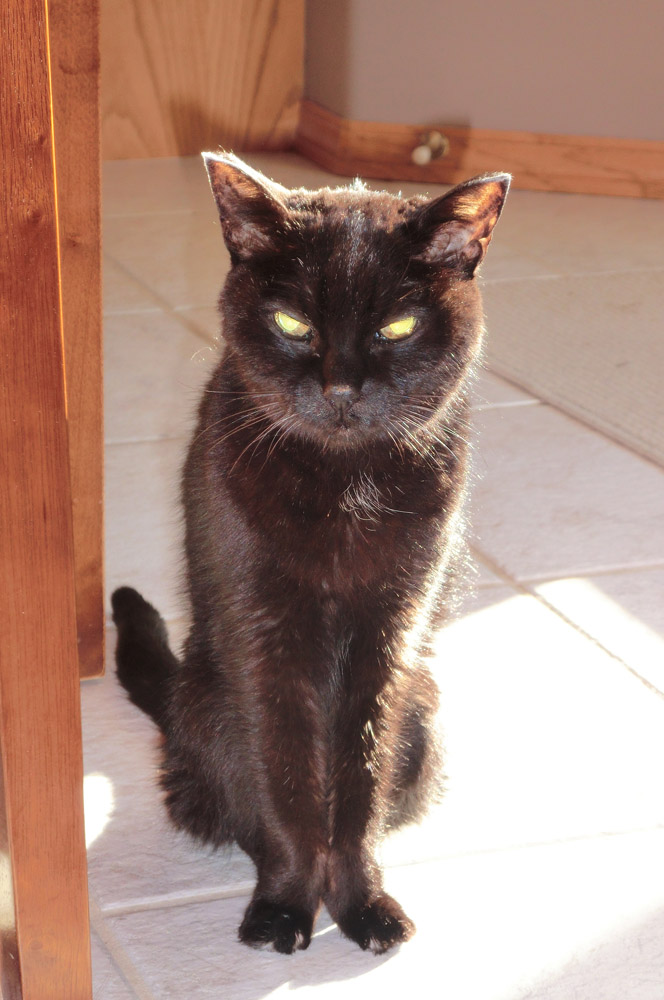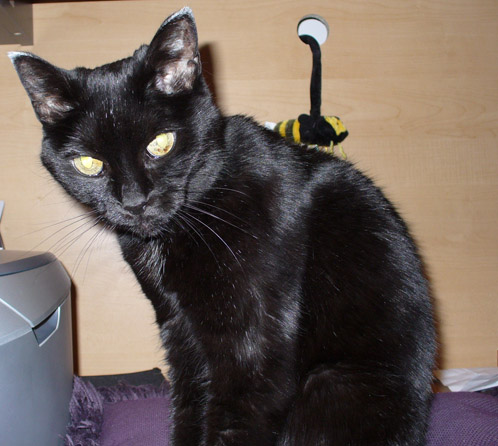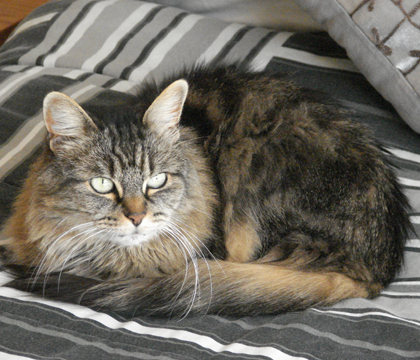Fortunately, my precious Bailey lived a long and happy life for another 13 years.
It's unknown what initially caused Bailey's kidney damage, but with the appropriate management strategies recommended by my veterinarian, I was able to keep her relatively stable for all of those years.
My experience with her and the education I've received as a student at the Western College of Veterinary Medicine (WCVM) have taught me that a diagnosis of CKD doesn't always mean a death sentence.
A fairly prevalent disease, CKD affects about one to three per cent of all geriatric cats. "It's among the top five diagnoses — if not the most common diagnosis — for an older cat that presents for weight loss with increased drinking and urination," says Dr. Elisabeth Snead, a WCVM small animal internal medicine specialist.
About 66 per cent of cats diagnosed with CKD succumb to the disease once they're over 10 years of age. The Maine coon, Abyssinian, Siamese, Russian blue and Burmese breeds seem to have a predisposition for the disease.
Kidneys: the ultimate multi-taskers
The kidneys are very important, multi-functional organs. Their top responsibility is to filter the blood and remove wastes through the production of urine. The kidneys also play a major role in regulating electrolyte concentrations, hydration, acid-base balance and blood pressure.
The kidneys also produce several important hormones. Erythropoietin produced by the kidneys is responsible for stimulating red blood cell production by the bone marrow.
As well, the kidneys aid in the production of active vitamin D, which is important for bone development and calcium and phosphorus balance in the body.
With this list of numerous duties, it's easy to see why damage to the kidneys can cause a whole host of problems.
Kidney disease occurs as a result of any sort of injury to the tissue whether that may be from physical trauma, an infection, toxin ingestion, inflammation or cancer.
Acute kidney disease occurs rapidly over a short period of time and may be reversible, depending on the underlying cause.
"With CKD, the decline in kidney function occurs over months to years from repeated insults to the kidney," explains Snead.
CKD isn't reversible, but it's possible to medically manage affected cats and slow the progression of the disease while maintaining a good quality of life.
Signs of CKD are non-specific and include weight loss with a normal or poor appetite, vomiting, constipation, increased drinking and urination, lethargy and weakness.
In advanced stages of the disease, cats may develop ulcers in the mouth, anemia or neurological problems such as seizures.
Most of these symptoms are related to the build-up of toxins in the body as well as the reduced ability of the kidneys to maintain hydration.
"Some cats can have CKD with little or no obvious signs," adds Snead. "Since it can be a very silent disease in the early stages, it's advisable to perform annual blood work for any cat over the age of 10 years. Catching it and treating it early can really help slow its progression."
Managing Itty Bitty's kidney disease

Excessive drinking and urination were the first signs that Saskatoon pet owner Wendy Donaldson noticed when her cat, Itty Bitty, was diagnosed with kidney disease.
"Itty Bitty always liked her water. She even played in it," says Donaldson. "But she started drinking so much that I knew something must be wrong with her kidneys."
Itty Bitty, a female black domestic shorthair cat, was diagnosed with CKD by Snead in the spring of 2010. The initial injury to her kidneys was likely due to the ingestion of lilies – plants that are often toxic, especially to cats.
The diagnosis of CKD is reached by obtaining a thorough history and performing a physical examination along with routine blood work and urinalysis.
"A urinalysis is essential for diagnosis," says Snead. "Urine is worth its weight in gold and should always be collected in patients that are having blood drawn for any reason as it plays a key role in allowing the kidney function to be assessed."
With Itty Bitty, an ultrasound exam was also done as part of the diagnostic process in order to rule out other causes of kidney disease such as stones in the urinary tract or cancer of one or both of the kidneys.
Devastated by Itty Bitty's diagnosis, Donaldson was reassured by Snead that it's possible to slow the progression of CKD with certain therapies.
Itty Bitty received intravenous fluids over two days at the WCVM's Veterinary Medical Centre. Along with medications to control her blood pressure, nausea and vomiting, Itty Bitty was sent home with fluids for her owner to inject daily under the skin.
"It's vitally important that animals with kidney disease are kept hydrated to avoid a uremic crisis," says Snead.
As urea (a nitrogenous substance created from the breakdown of protein) and other waste products normally excreted in urine begin to accumulate in the blood, the outward symptoms of kidney disease become apparent. This is referred to as uremia or a uremic crisis.
Another important step towards controlling her cat's CKD involved Donaldson switching Itty Bitty's food to a strict, lower-protein diet.
"The rationale is that reduced protein diets result in decreased urea and phosphorus concentrations in the blood, helping to reduce the severity of uremic signs," explains Snead.

She adds that kidney diets encompass a variety of modifications including limited quantities of phosphorus and salt and enhanced levels of omega-3 fatty acids, fiber and vitamin D.
However, not all cats will eat a commercial kidney diet. Sometimes owners need advice on making a suitable homemade diet, or they need advice on how to slowly lower their pet's protein intake.
Other considerations for treating and managing CKD include appetite stimulants, vitamin supplements, antacids to minimize ulcer formation and medications to decrease urea reabsorption.
In some cases, blood transfusions and iron supplementation may be necessary to combat anemia. As well, placement of a feeding tube can be helpful for long-term caloric support for persistently anorexic patients who aren't vomiting.
According to Snead, one of the most important therapeutic interventions is phosphorus restriction, which can be accomplished through feeding a reduced protein diet or the administration of enteric phosphate binders – medications that bind phosphate, decreasing its absorption in the intestinal tract.
"The goal of supportive and symptomatic therapy is to make the patient feel better and improve their quality of life," stresses Snead.
Monitoring key to managing CKD
The treatment plan for patients with CKD is highly dependent on the stage of kidney disease. Over time, treatments often need to be changed so it's important to monitor the patient's disease status through repeat bloodwork, urinalysis and examination.
"We visited Dr. Snead every one to two months initially," says Donaldson. "Once we had Itty Bitty's treatment figured out, we returned for a recheck every six months."
After eight months of at-home fluid therapy, repeat laboratory tests revealed that Itty Bitty's CKD was well controlled.
"After Itty Bitty was diagnosed, we didn't think she would live out the year. But with Dr. Snead's treatment plan, we extended her life for two years," says Donaldson, who lost 20-year-old Itty Bitty in March 2012.
"Dr. Snead and the WCVM were wonderful to us," she adds. "They really helped us with the treatments and any questions. For that, I'm grateful."
While there's no way to entirely prevent CKD, Snead does offer some suggestions to help reduce the chances of developing the disease.
"Maintaining good hydration is key," she says. "Once your cat is over 10 years of age, increase his or her water intake by adding water to a kibble diet or offering canned food. This will help promote blood flow to the kidneys and preserve kidney function."
Snead also advises keeping cats indoors to help minimize exposure to toxins or trauma.
Although CKD often carries a grim prognosis, Donaldson knows firsthand that steps can be taken to decrease the rate of its progression.
"It isn't always a death sentence," she says. "It's important to talk to your veterinarian about all your options and don't give up."
Robyn Thrasher of Edmonton, Alta., is a third-year veterinary student at the WCVM. Robyn is a WCVM research communications intern as well as a summer student in the WCVM Veterinary Medical Centre during the summer of 2012.
It's unknown what initially caused Bailey's kidney damage, but with the appropriate management strategies recommended by my veterinarian, I was able to keep her relatively stable for all of those years.
My experience with her and the education I've received as a student at the Western College of Veterinary Medicine (WCVM) have taught me that a diagnosis of CKD doesn't always mean a death sentence.
A fairly prevalent disease, CKD affects about one to three per cent of all geriatric cats. "It's among the top five diagnoses — if not the most common diagnosis — for an older cat that presents for weight loss with increased drinking and urination," says Dr. Elisabeth Snead, a WCVM small animal internal medicine specialist.
About 66 per cent of cats diagnosed with CKD succumb to the disease once they're over 10 years of age. The Maine coon, Abyssinian, Siamese, Russian blue and Burmese breeds seem to have a predisposition for the disease.
Kidneys: the ultimate multi-taskers
The kidneys are very important, multi-functional organs. Their top responsibility is to filter the blood and remove wastes through the production of urine. The kidneys also play a major role in regulating electrolyte concentrations, hydration, acid-base balance and blood pressure.
The kidneys also produce several important hormones. Erythropoietin produced by the kidneys is responsible for stimulating red blood cell production by the bone marrow.
As well, the kidneys aid in the production of active vitamin D, which is important for bone development and calcium and phosphorus balance in the body.
With this list of numerous duties, it's easy to see why damage to the kidneys can cause a whole host of problems.
Kidney disease occurs as a result of any sort of injury to the tissue whether that may be from physical trauma, an infection, toxin ingestion, inflammation or cancer.
Acute kidney disease occurs rapidly over a short period of time and may be reversible, depending on the underlying cause.
"With CKD, the decline in kidney function occurs over months to years from repeated insults to the kidney," explains Snead.
CKD isn't reversible, but it's possible to medically manage affected cats and slow the progression of the disease while maintaining a good quality of life.
Signs of CKD are non-specific and include weight loss with a normal or poor appetite, vomiting, constipation, increased drinking and urination, lethargy and weakness.
In advanced stages of the disease, cats may develop ulcers in the mouth, anemia or neurological problems such as seizures.
Most of these symptoms are related to the build-up of toxins in the body as well as the reduced ability of the kidneys to maintain hydration.
"Some cats can have CKD with little or no obvious signs," adds Snead. "Since it can be a very silent disease in the early stages, it's advisable to perform annual blood work for any cat over the age of 10 years. Catching it and treating it early can really help slow its progression."
Managing Itty Bitty's kidney disease

Excessive drinking and urination were the first signs that Saskatoon pet owner Wendy Donaldson noticed when her cat, Itty Bitty, was diagnosed with kidney disease.
"Itty Bitty always liked her water. She even played in it," says Donaldson. "But she started drinking so much that I knew something must be wrong with her kidneys."
Itty Bitty, a female black domestic shorthair cat, was diagnosed with CKD by Snead in the spring of 2010. The initial injury to her kidneys was likely due to the ingestion of lilies – plants that are often toxic, especially to cats.
The diagnosis of CKD is reached by obtaining a thorough history and performing a physical examination along with routine blood work and urinalysis.
"A urinalysis is essential for diagnosis," says Snead. "Urine is worth its weight in gold and should always be collected in patients that are having blood drawn for any reason as it plays a key role in allowing the kidney function to be assessed."
With Itty Bitty, an ultrasound exam was also done as part of the diagnostic process in order to rule out other causes of kidney disease such as stones in the urinary tract or cancer of one or both of the kidneys.
Devastated by Itty Bitty's diagnosis, Donaldson was reassured by Snead that it's possible to slow the progression of CKD with certain therapies.
Itty Bitty received intravenous fluids over two days at the WCVM's Veterinary Medical Centre. Along with medications to control her blood pressure, nausea and vomiting, Itty Bitty was sent home with fluids for her owner to inject daily under the skin.
"It's vitally important that animals with kidney disease are kept hydrated to avoid a uremic crisis," says Snead.
As urea (a nitrogenous substance created from the breakdown of protein) and other waste products normally excreted in urine begin to accumulate in the blood, the outward symptoms of kidney disease become apparent. This is referred to as uremia or a uremic crisis.
Another important step towards controlling her cat's CKD involved Donaldson switching Itty Bitty's food to a strict, lower-protein diet.
"The rationale is that reduced protein diets result in decreased urea and phosphorus concentrations in the blood, helping to reduce the severity of uremic signs," explains Snead.

She adds that kidney diets encompass a variety of modifications including limited quantities of phosphorus and salt and enhanced levels of omega-3 fatty acids, fiber and vitamin D.
However, not all cats will eat a commercial kidney diet. Sometimes owners need advice on making a suitable homemade diet, or they need advice on how to slowly lower their pet's protein intake.
Other considerations for treating and managing CKD include appetite stimulants, vitamin supplements, antacids to minimize ulcer formation and medications to decrease urea reabsorption.
In some cases, blood transfusions and iron supplementation may be necessary to combat anemia. As well, placement of a feeding tube can be helpful for long-term caloric support for persistently anorexic patients who aren't vomiting.
According to Snead, one of the most important therapeutic interventions is phosphorus restriction, which can be accomplished through feeding a reduced protein diet or the administration of enteric phosphate binders – medications that bind phosphate, decreasing its absorption in the intestinal tract.
"The goal of supportive and symptomatic therapy is to make the patient feel better and improve their quality of life," stresses Snead.
Monitoring key to managing CKD
The treatment plan for patients with CKD is highly dependent on the stage of kidney disease. Over time, treatments often need to be changed so it's important to monitor the patient's disease status through repeat bloodwork, urinalysis and examination.
"We visited Dr. Snead every one to two months initially," says Donaldson. "Once we had Itty Bitty's treatment figured out, we returned for a recheck every six months."
After eight months of at-home fluid therapy, repeat laboratory tests revealed that Itty Bitty's CKD was well controlled.
"After Itty Bitty was diagnosed, we didn't think she would live out the year. But with Dr. Snead's treatment plan, we extended her life for two years," says Donaldson, who lost 20-year-old Itty Bitty in March 2012.
"Dr. Snead and the WCVM were wonderful to us," she adds. "They really helped us with the treatments and any questions. For that, I'm grateful."
While there's no way to entirely prevent CKD, Snead does offer some suggestions to help reduce the chances of developing the disease.
"Maintaining good hydration is key," she says. "Once your cat is over 10 years of age, increase his or her water intake by adding water to a kibble diet or offering canned food. This will help promote blood flow to the kidneys and preserve kidney function."
Snead also advises keeping cats indoors to help minimize exposure to toxins or trauma.
Although CKD often carries a grim prognosis, Donaldson knows firsthand that steps can be taken to decrease the rate of its progression.
"It isn't always a death sentence," she says. "It's important to talk to your veterinarian about all your options and don't give up."
Robyn Thrasher of Edmonton, Alta., is a third-year veterinary student at the WCVM. Robyn is a WCVM research communications intern as well as a summer student in the WCVM Veterinary Medical Centre during the summer of 2012.
Share this story
